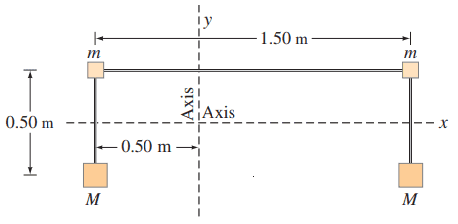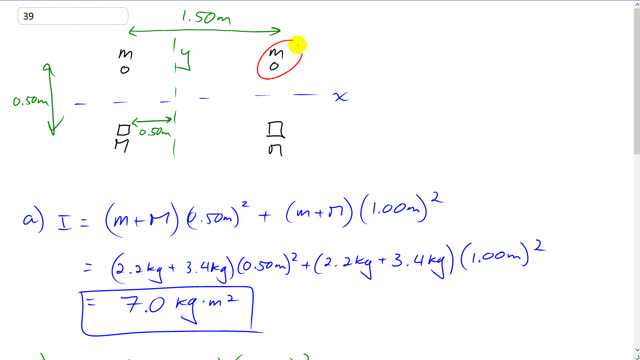
Calculate the moment of inertia of the array of point objects shown in Fig. 8–47 about
- the y axis, and
- the x axis. Assume m = 2.2 kg, M = 3.4 kg, and the objects are wired together by very light, rigid pieces of wire. The array is rectangular and is split through the middle by the x axis.
- About which axis would it be harder to accelerate this array?

- y-axis

In order to watch this solution you need to have a subscription.
This is Giancoli Answers with Mr. Dychko. The moment of inertia about the y-axis is the sum of the moment of inertia's of each of these four point masses. Each of them has a moment of inertia formula equal to I equals m times its distance to the axis of rotation squared. So we have one little mass and one large mass, both of them are distance of 0.50 meters away from the y-axis. And so we go m plus M times 0.50 meter squared and then add to that the moment of inertia's for each of these two distant masses here and so that's little m plus M times its 1 meter distance away from the y-axis squared. And so substituting in values for m and M: we have 2.2 kilograms plus 3.4 kilograms times 0.50 meters squared plus 2.2 plus 3.4 times 1.00 meter squared which gives 7.0 kilogram meter squared moment of inertia about the y-axis. Now for the x-axis, we have everything at the same distance from the axis of rotation. So we have two little masses and and then two big masses all getting multiplied by the same thing; this separation here divided by 2 because we are told that the x-axis cuts down the middle and so the distance from this axis of rotation to any of the masses is 0.5 meters divided by 2 and so we square this denominator which makes 4 and then that cancels with a... this a common factor 2 on top and bottom in other words and we end up with just divide by 2 in the end after squaring the denominator. And so we have m plus M times 0.50 meters squared divided by 2 and plugging in numbers you get 0.70 kilogram meter squared. So the moment of inertia is much smaller above the x-axis and we expect that since the masses are so much closer to the x-axis than they are to the y-axis. And so it is harder to accelerate the system about the y-axis since the moment of inertia is about 10 times greater about the y-axis than it is about the x-axis. So for a given angular acceleration, we would need 10 times as much torque since the moment of inertia is 10 times greater about the y-axis.
Aren't different equations for the moment of inertia supposed to be used for different objects? In this case shouldn't the equation be I=1/3mr^2 for a stick?
https://phys.libretexts.org/Bookshelves/University_Physics/Book%3A_Mech…